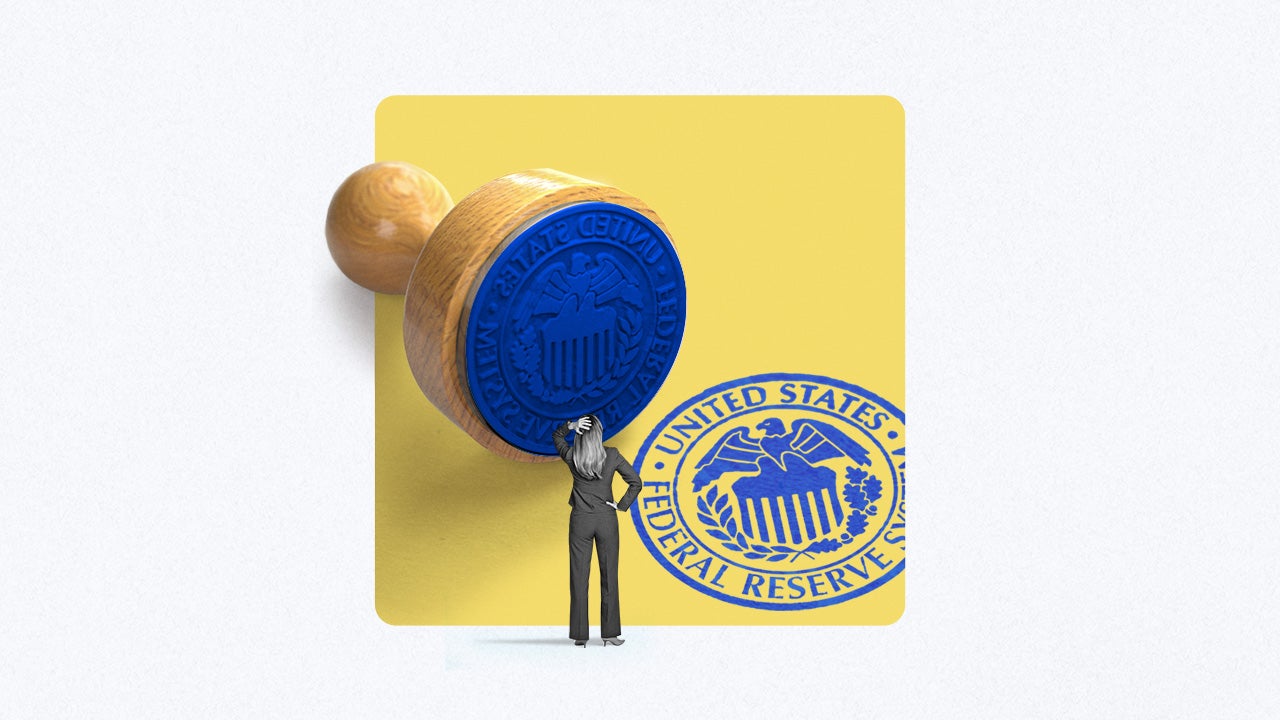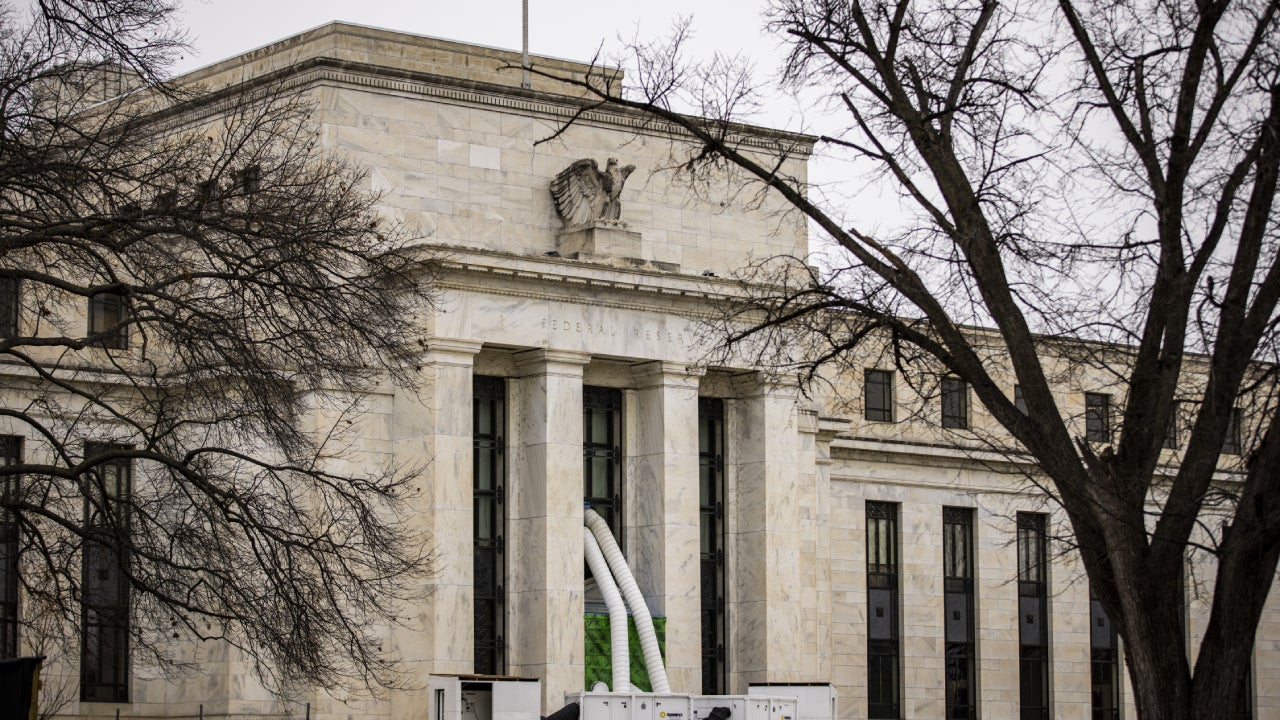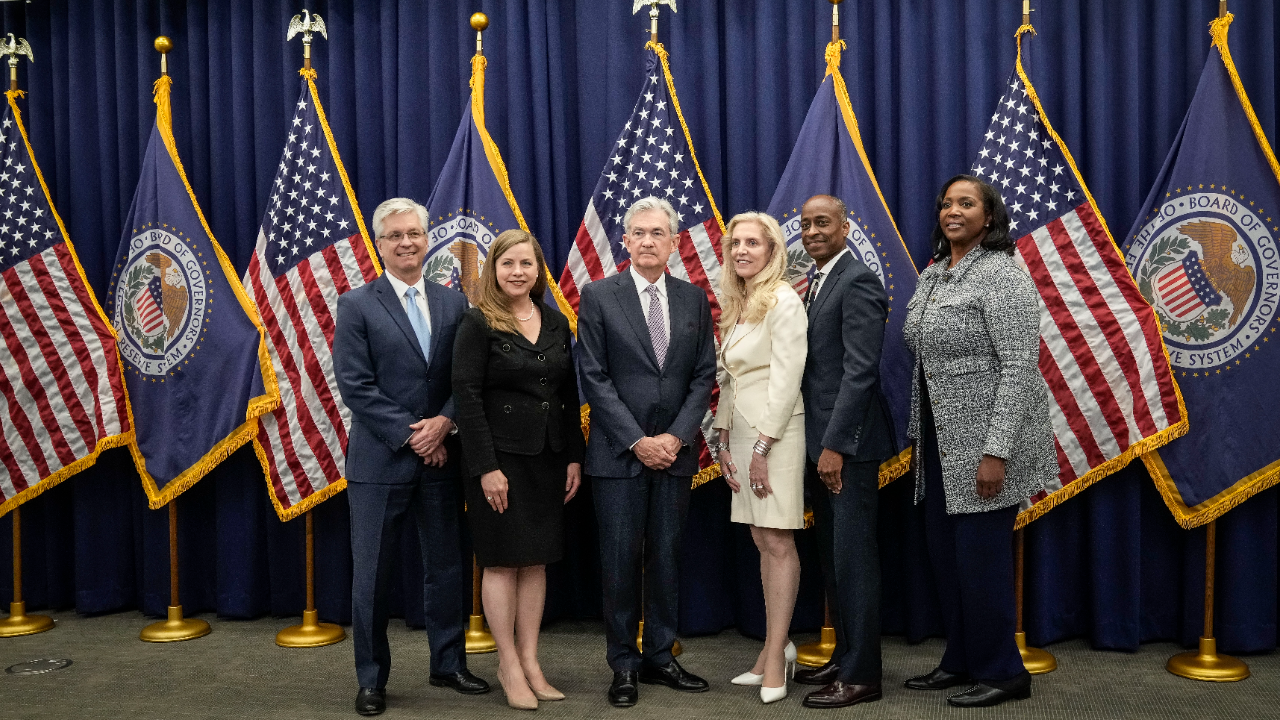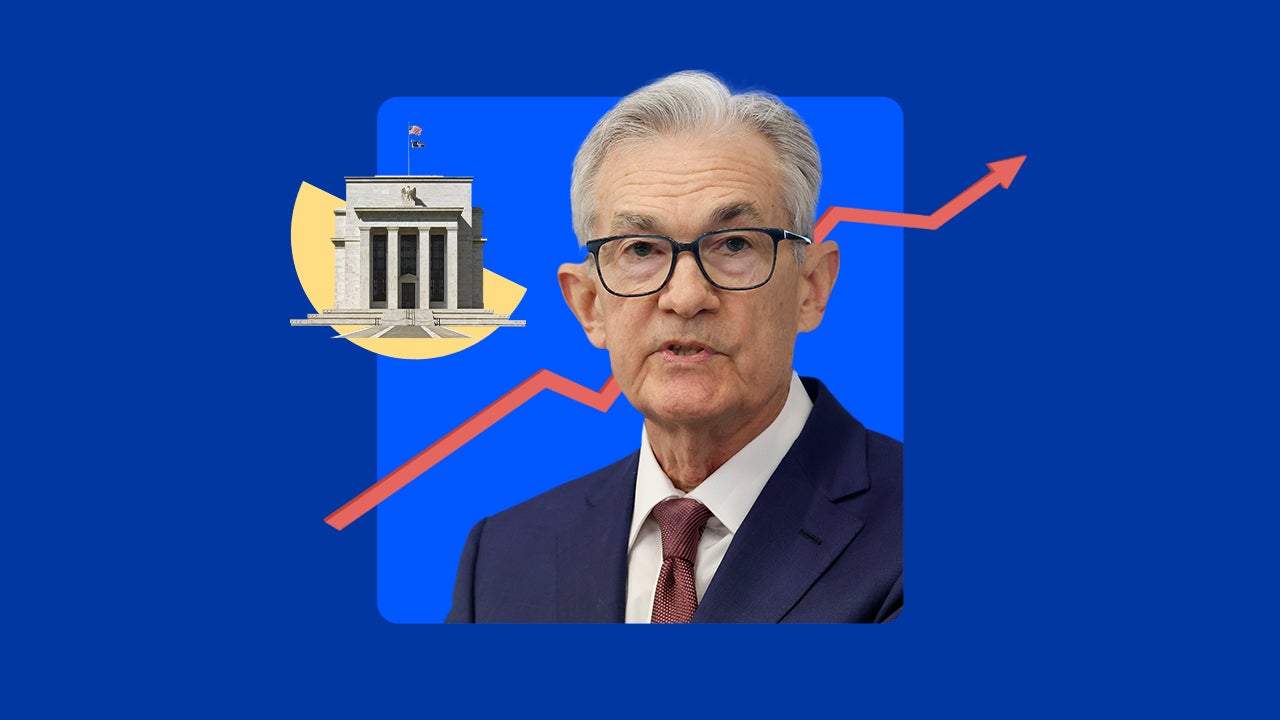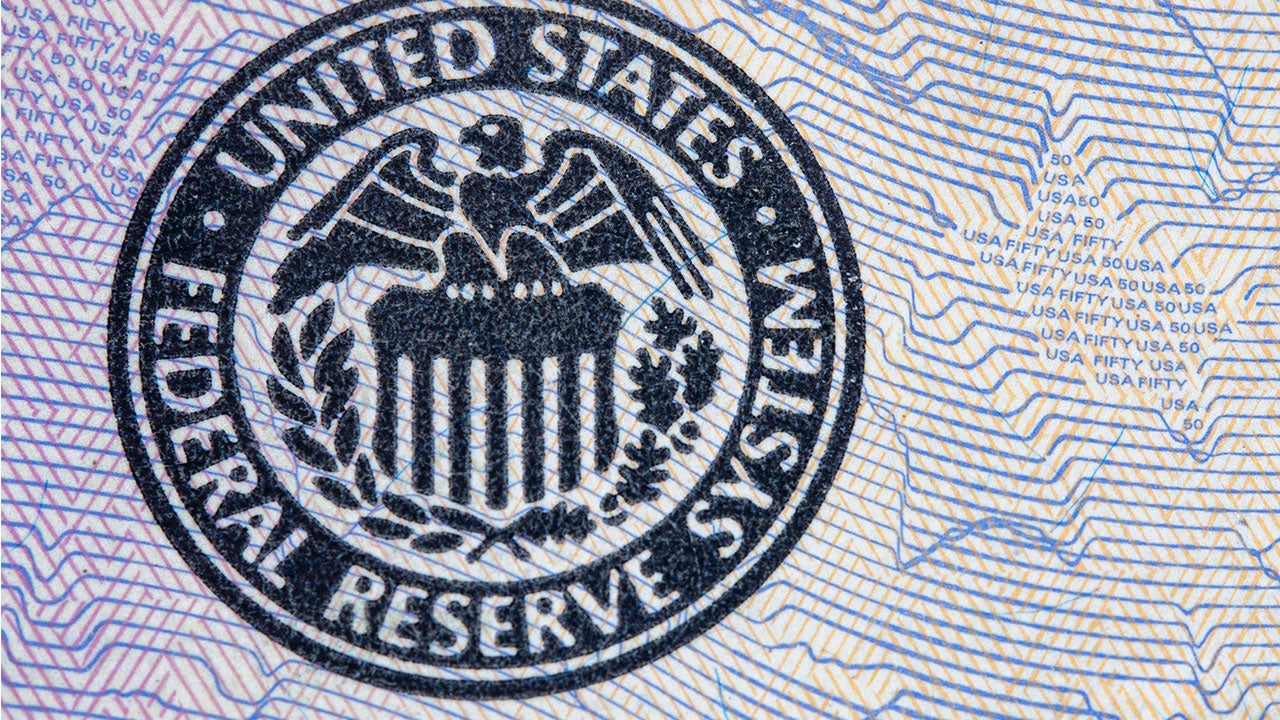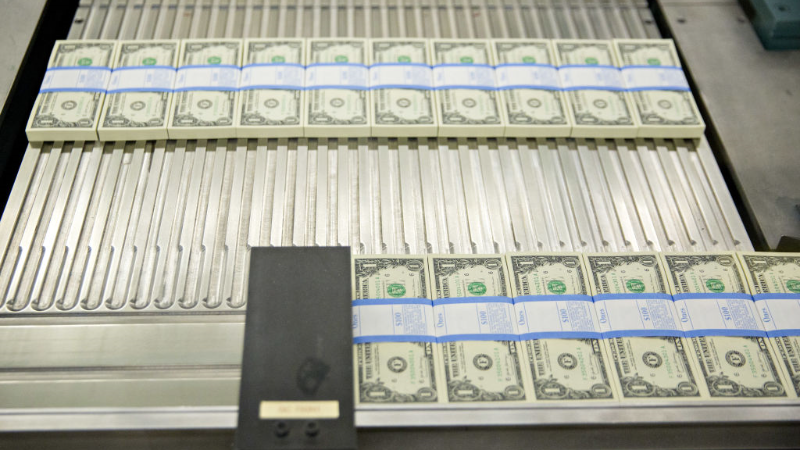What is the Federal Reserve? A guide to the world’s most powerful central bank
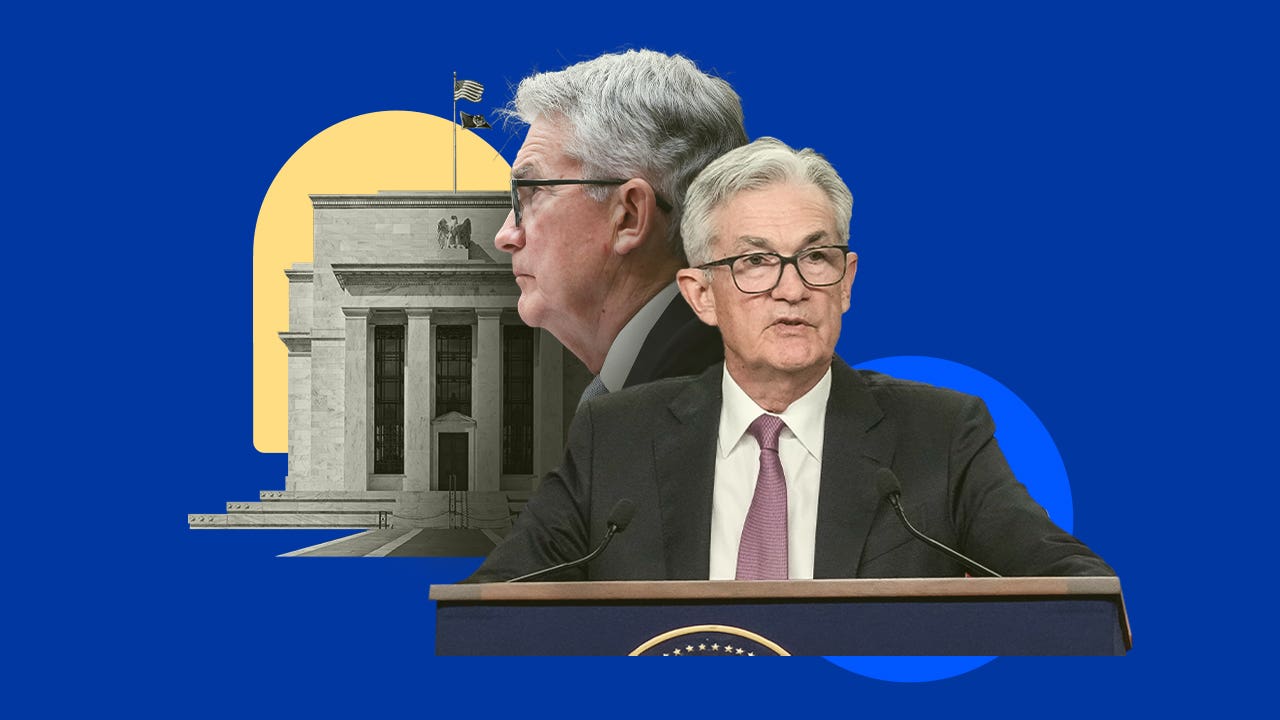
Key takeaways
- The Federal Reserve, the central bank of the U.S., is responsible for setting monetary policy and promoting maximum employment, stable prices and financial stability.
- The Fed's decisions, including interest rate adjustments, directly impact consumers' wallets and can significantly impact their financial decisions.
- While the Fed has independence in its decision-making, it is still overseen by Congress and undergoes audits to ensure accountability.
The banks’ bank. The lender of last resort. The orchestrator of the U.S. economy. These words are often used to describe the central bank of the U.S., officially known as the Federal Reserve System.
Investors and economists alike obsess over every word and sentence that comes out of the Fed, whether it’s public speeches from Fed officials or statements issued after meetings by its policymaking arm, the Federal Open Market Committee (FOMC).
But even though the Fed’s work seems so complicated that only financial experts should care, the Fed’s decisions directly impact your wallet and can make-or-break your major financial decisions — arguably more so than any other policymaker in Washington.
Understanding the world’s most powerful central bank has been especially important during the Fed’s most forceful inflation fight in 40 years. The Fed’s actions have made key consumer loans, from mortgages to car loans, more expensive — but have also led to generous returns for savers. The nation’s top banks are paying 5 percent or more a year on consumers’ savings, the highest in more than a decade.
While politicians often take credit or blame for the performance of the economy and the job market, it is the Federal Reserve that is more directly responsible.— Greg McBride, CFA | Bankrate chief financial analyst
Here’s everything you need to know about the Fed, including what it does and the purpose it serves.
What is the Federal Reserve?
The Federal Reserve, frequently dubbed “the Fed” for short, is the central bank of the U.S. Whereas fiscal lawmaking is left up to the three branches of government, the Fed sets monetary policy, mainly by adjusting interest rates, the money supply and bank regulations to foster economic stability.
Other countries, such as Canada, India, the United Kingdom and Japan, have their own iterations of the Fed. The European Central Bank sets policy for the European Union.
After a panic stoked a lack of trust and confidence in the banks, Congress created the current version of the Fed (there have been two others) in 1913, tasking it with maintaining “a safer, more flexible and more stable monetary and financial system.”
@bankrate If you haven’t been following the Fed, take this as your sign to start 🏦💵 #inflation #stocks #economy ♬ original sound – Bankrate | Financial Education
The broader Fed system has three pillars: the board of governors, the 12 regional reserve banks and the FOMC.
Board of governors
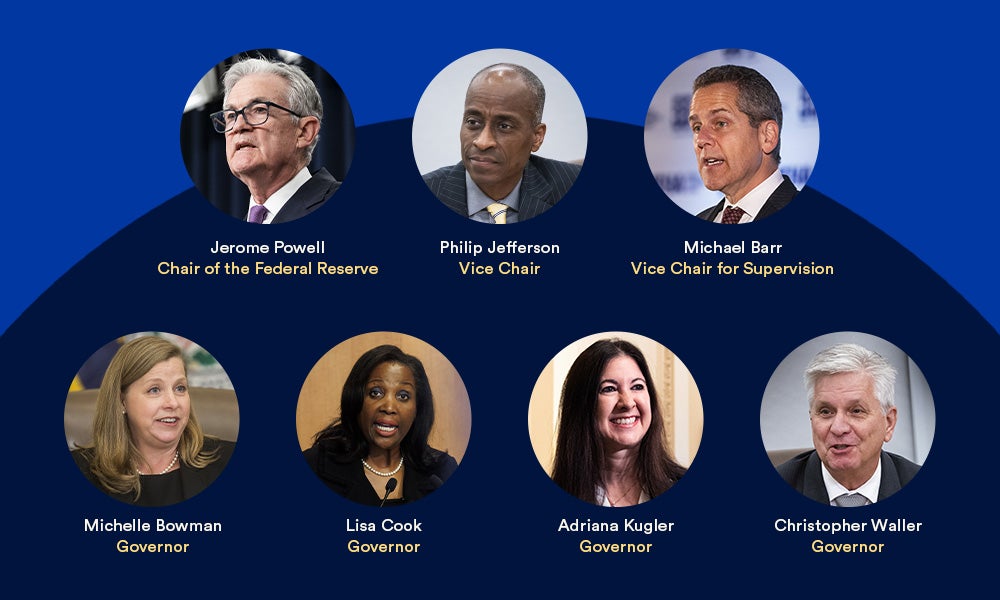
The board of governors in Washington is a seven-member board that supervises the entire Fed system. The president appoints each official, and then they are confirmed in the Senate.
Currently, those members are:
- Jerome Powell, chair
- Philip Jefferson, vice chair
- Michael Barr, vice chair for supervision
- Michelle Bowman, governor
- Lisa Cook, governor
- Adriana Kugler, governor
- Christopher Waller, governor
On top of that, the board houses about 3,000 other employees, many of whom conduct research on broader macroeconomic issues to help inform policymakers.
Regional reserve banks
The 12 regional reserve banks, on the other hand, are scattered throughout the country. Each has its own president and board of directors, who stay informed on their regional economies and report those findings back to the board.
Congress created these regional banks to ensure that the Fed was a “decentralized” central bank, meaning it didn’t just concern itself with what was happening on Wall Street or Capitol Hill. The presidents of each of the banks have to be approved by the Fed’s board but are selected through an independent search committee headed by the regional reserve bank’s board of directors.
FOMC
These two components combine to make the FOMC, the third tier and perhaps the most influential aspect of the Fed.
At eight meetings a year (sometimes more during emergencies), all seven governors and five of the 12 reserve bank presidents vote to decide whether to raise or lower interest rates and conduct monetary policy.
What does the Federal Reserve do?
The Federal Reserve has five key functions to help promote a strong economy:
- Conducting monetary policy: The U.S. central bank’s most well-known function. Monetary policy primarily refers to the Fed’s interest rate decisions, which help steer the U.S. economy toward its two main goals: stable prices and maximum employment.
- Promoting financial stability: The Fed is tasked with ensuring that financial markets continue running smoothly — even during periods of volatility — so businesses, communities, households and other key economic players can access the services they need to keep spending and investing.
- Supervising and regulating the nation’s banks: In the aftermath of the financial crisis of 2008, Fed officials took on a key role in monitoring the activities and operations of the nation’s banks — from the smallest community banks to the country’s largest financial firms — to ensure those institutions are financially sound and following existing laws or regulations.
- Connecting with communities: Since kicking off a framework review in 2019, Fed officials have prioritized not just looking at economic data but also meeting with community leaders, workers and business owners to learn how the economy and monetary policy is affecting them.
- Fostering a strong payments system: The Fed provides financial services to banks and helps put money in circulation to ensure that consumers, businesses and workers can get paid for their services and continue having access to the funds that they need for spending — whether by cash, checks or electronic transactions. Such examples include the Fed’s discount window or its automated clearinghouse (ACH) services.
The Fed’s influence on inflation, the job market and the economy
During FOMC meetings, officials have three options: Raise interest rates, lower them or maintain them.
Think of the U.S. economy as having a speed limit. If it moves too fast, it risks overheating, leading to inflation. Low unemployment means consumers likely have stable, consistent paychecks, giving them more buying power. Companies might ultimately need to raise prices, unable to keep up with the massive uptick in demand for their goods and services. Those businesses might also have to boost wages to lure more talent as the pool of available workers shrinks.
In those periods, the Fed will thus push on the brakes by raising its key benchmark interest rate, the federal funds rate.
Each time the Fed adjusts interest rates, consumer borrowing costs move in lockstep. Higher rates on mortgages, car loans, personal loans and more might lead some consumers to delay big-ticket purchases that require financing. Businesses might think twice about investments or hiring expansions. Slower hiring takes away from consumers’ purchasing power in itself, while reduced spending weighs on economic activity. All of those forces combine to slow the economy — and consequently show why higher interest rates weigh on inflation.
On the contrary, when the U.S. economy faces a recession or if unemployment picks up substantially, the Fed will cut rates to prop up businesses and consumers. Consumers who’ve been waiting for the right moment to finance a big-ticket purchase might finally be inspired to purchase one. Businesses, meanwhile, might eventually decide to pursue the investments that they had delayed when borrowing costs were high. Those decisions cycle back into the economy, acting as a stimulus for growth.
The Fed has also occasionally lowered interest rates when storm clouds are on the horizon, in an attempt to shore up an economic expansion. The Fed in 2019, for example, reduced rates at three straight meetings amid slowing global growth, the U.S.-China trade war and a realization that the labor market wasn’t as tight as officials previously thought.
“If the Fed raises interest rates too fast or too far, for example, an economic slowdown or a broad contraction could result,” McBride says. “Similarly, by cutting interest rates, they can give the economy a needed boost by making it cheaper for consumers and businesses to borrow.”
The Fed’s monetary policy toolkit
The Fed uses more than just interest rates to influence the U.S. economy. The other features of its crisis toolkit include:
- Large-scale asset purchases: The Fed’s rate decisions traditionally affect only shorter-term borrowing. To loosen longer-term rates (such as mortgages) in times of severe economic distress, the Fed will purchase longer-term assets issued by the U.S. government or government-sponsored agencies, such as Fannie Mae or Freddie Mac. These programs are commonly referred to as “quantitative easing.”
- 13(3) emergency lending programs: With funds from the Treasury Department to cover potential losses, the Fed can create special lending facilities to purchase debt that isn’t backed by the federal government (such as municipal bonds or corporate debt) to provide funding to distressed corners of the economy. The Fed has only used these tools three times in its history, including during the coronavirus pandemic.
- Discount window: Regardless of the economic environment, the Fed has a special funding program for banks in need of capital, known as the discount window. Typically, however, banks have to pay a higher interest rate to seek capital from the Fed, a move intended to incentivize banks to lend to each other instead. That’s unless the U.S. economy is in a severe recession, in which case the Fed may remove those penalties.
These aggressive policy moves were crucial to the Fed’s coronavirus pandemic response. As the virus swept the nation and roiled both businesses and markets around the globe, the Fed threw out all the stops. In addition to slashing interest rates to near-zero, officials also rolled out an “unlimited” bond-buying program and created nine different categories of special lending programs to get funding to virtually every key economic player.
And sometimes, the power of the pen can be just as mighty as the Fed’s sword. After the Sept. 11 terrorist attacks, for example, then Fed Chairman Alan Greenspan made a swift announcement that the Fed’s discount window was open, hoping to quell panic.
How does the Federal Reserve impact my finances?
The Fed’s work is so complicated that it often gets misunderstood — or outright ignored. But it isn’t something to gloss over.
You’ll feel all of the Fed’s decisions in your wallet. When the Fed raises or lowers interest rates, yields on key consumer saving products from savings accounts and certificates of deposit move in tandem. Bankrate’s highest-yielding savings account has offered a 5.35 percent annual percentage yield (APY) since December — payouts that wouldn’t have happened without the Fed’s massive rate hikes. Credit card rates are the highest on record, while car loan rates are the highest since before the Great Recession, Bankrate data shows. Mortgage rates aren’t directly impacted by Fed decisions, but they’re influenced by the same external market factors that guide the Fed. The average rate on a 30-year fixed mortgage hit 7 percent in March after surging past 8 percent in October for the first time in over two decades.
“If you want to get a loan, the interest rate you pay on the loan is influenced by what the Fed is up to,” says Eric Sims, economics professor at the University of Notre Dame. “If you are a senior citizen living on fixed income payments, you care a lot about what’s happening to prices in the economy. If you’re a creditor of someone who’s borrowing or if you’re a borrower, you care about what the Fed is doing. [The Fed] directly influences the decisions you make.”
Not to mention, the Fed’s two economic objectives have enormous implications for U.S. consumers. If rates are too low and spur inflation, households lose their purchasing power. If the Fed raises interest rates too much, the economy can slow, harming Americans’ job prospects and bargaining power for higher wages.
The Federal Reserve’s mandate
The Fed doesn’t arbitrarily adjust interest rates. U.S. central bankers have a dual mandate: maximum employment and stable prices. In the Fed’s ideal economy, everyone who wants a job can find one, while inflation is predictable and tame enough not to diminish consumers’ purchasing power.
But that dual mandate might as well be called a dueling mandate. Inflation and unemployment tend to have an inverse relationship. Lower inflation might require a slower economy and higher unemployment, while tight job markets could spark damaging price pressures if companies have to raise wages to lure talent. The Fed uses interest rates to steer the U.S. economy toward either outcome.
“If the labor market is too tight, it generates inflation,” Sims says. “If the labor market is too loose, this is going to generate deflation. Depending on how you weigh what’s going on in the labor market versus what’s happening to inflation, that sort of informs your opinions on how you want to adjust interest rates and what the potential consequences are.”
There’s no right answer for whether employment or inflation matters more, Sims says. As a result, many officials favor sacrificing one for the other. For decades, Fed watchers have been grouping those Fed officials into two camps: “hawks” and “doves.”
- “Hawks” are most predominantly concerned with inflation, often dissuading against too-loose interest rates to keep price pressures under control.
- “Doves” are focused on the job market, often willing to stomach higher inflation to ensure Americans remain employed.
“It’s a difficult problem to solve,” Sims says. “You have to balance different sectors of the economy, and some are more sensitive than others. If they’re deemed important to full employment, maybe the Fed is willing to tolerate some inflation to try to stimulate those sectors.”
What economic data does the Fed keep an eye on?
The Fed’s dual mandate requires that officials keep a close watch on employment and inflation figures, such as the monthly jobs report, the consumer price index (CPI) and the personal consumption expenditures (PCE) index — the latter of which is officials’ preferred gauge for tracking price increases.
Officials have a specific inflation target of 2 percent, which they officially defined in 2012. It’s a goldilocks rate, one that’s neither too high nor too low.
But officials keep a close watch on other economic figures that could bring different outcomes for employment and inflation down the road. Those can include:
- Gross domestic product (GDP): The broadest scorecard of the U.S. economy, indicating how much the U.S. economy is expanding.
- Business investment: A line within GDP, businesses’ spending on physical capital from land to buildings could show whether employers are planning to cut back or grow.
- Consumer spending: Consumption keeps the engines of the economy growing — but can sometimes lead to inflation if robust demand for goods and services eclipses supply.
- Wage growth: If the labor market is too tight, companies might decide to pay workers more, then pass along those increases in the form of higher prices to consumers.
Does the president or Congress control the Fed?
The Fed doesn’t have to seek presidential or congressional approval when deciding what to do with interest rates. Instead, it’s given complete authority. The idea is, if the president has control over the Fed’s decisions, it will likely only approve a policy that supports a political interest, rather than what’s best for the broader economy. (Presidents, for example, have historically preferred low interest rates to keep the economy booming).
That’s not to say, however, that the Fed doesn’t have oversight. The Fed is audited every year by an independent accounting firm, as well as the Government Accountability Office. Results are then published in March of the following year on the board’s website. In addition, Congress acts as its overseer, with the Fed chair having to report to Capitol Hill twice a year to testify on the Fed’s monetary plans and actions.
How does the Fed influence interest rates?
When setting interest rates, the U.S. central bank doesn’t tell lenders to charge a specific rate. Most interest rates you see on consumer products are privately determined, depending on financial institutions’ own profit-making margins and consumers’ creditworthiness.
But everything that happens with the borrowing costs consumers pay almost always point back to the benchmark rate that the Fed controls.
The Fed’s fed funds rate is the interest rate that financial institutions charge each other for overnight lending — and if it becomes more expensive for banks to borrow money from each other, it’ll ultimately become more expensive for the consumers who bank with them, too.
But thanks to the Fed’s massive asset purchases after both the financial crisis and coronavirus pandemic, the money supply has ballooned — translating to a greater level of bank reserves. Simply put, banks don’t need to lend to each other overnight as much.
That’s where some important tools come in to ensure the fed funds rate stays in check:
- Primary tool: Interest on reserve balances (IORB). Similar to how it works for everyday consumers, banks who deposit funds in accounts at the Fed earn interest on their reserves. This is a no-risk option, serving as a floor for interest rates. In other words, why would a bank accept less money without the guarantee that it could get paid back?
- Supplementary tool: Overnight reverse repurchase agreement facility (ON RRP). For banks that don’t earn interest on reserve balances, they can deposit reserves overnight in a special Fed facility, receiving a government security as collateral. The next day, the Fed buys back that security, with interest.
- Old tool: Open market operations. Another side effect of the Fed’s ballooning balance sheet, the Fed’s old method for ensuring the fed funds rate stays in its desired target range — buying and selling government securities on the open market — also isn’t as effective. But while it’s no longer the Fed’s primary tool for influencing interest rates, the Fed will still periodically purchase securities and inject more reserves in the banking system to maintain a level of reserves the Fed considers “ample.”
“If the Fed increases the rate that they’re paying banks to hold reserves, it’s going to reduce the incentive for banks to lend out funds,” Sims says. “If I can earn 4 percent by holding reserves at the Fed, it’s not a good deal to lend it out to you at 4.5 percent, given that you’re a little risky.”
On the flip side, if the Fed wants to incentivize banks to lend out their excess reserves (rather than keeping them at the Fed), the FOMC will lower the interest rate that it pays on them. That increases the amount of available credit in the economy, thus lowering interest rates.
The fed funds rate has been as high as 19-20 percent, a level that Fed officials pushed rates up to the last time they combatted inflation in the 1980s. During the coronavirus pandemic and Great Recession, Fed officials slashed borrowing costs all the way down to 0-0.25 percent, the lowest its benchmark can go without dipping into negative territory.
Currently, the Fed’s key interest rate is in a target range of 5.25-5.5 percent, the highest since 2001 as U.S. central bankers wrestle post-pandemic inflation.



